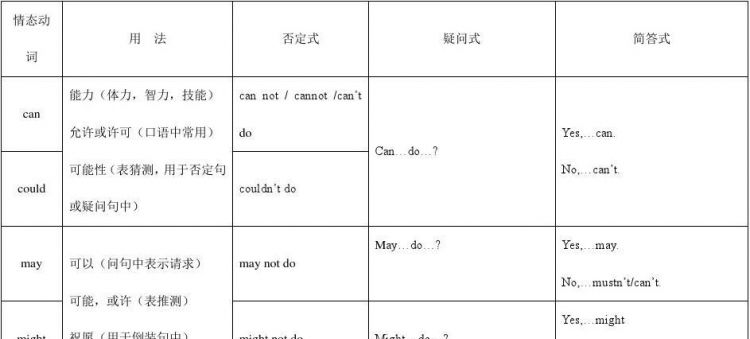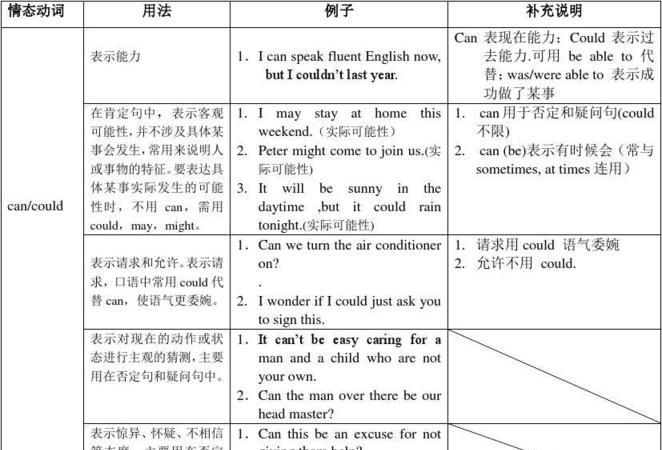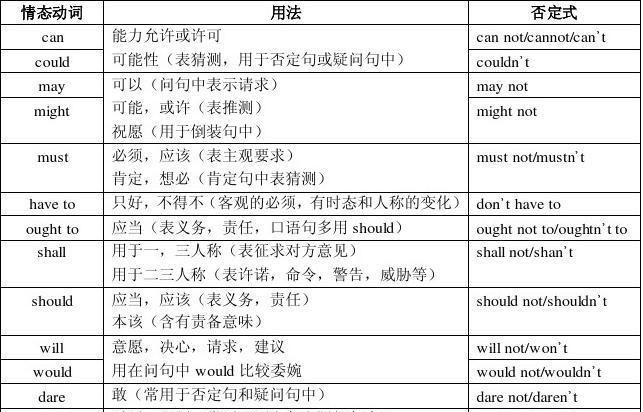本文目录
英语情态动词用法归纳
should
have+done
sth
意思:本该做什么,但是没有做。
For
example:
You
should
have
come
earlier.
你本该早点来。(言外之意就是你来得太晚了)

高中情态动词的用法归纳总结
1)
may(might)
have
+
done
sth,
can
(could)
have
+
done
sth
表示过去,推测过去时间里可能发生的事情。
Philip
may
(might)
have
been
hurt
seriously
in
the
car
accident.
Philip
can
(could)
have
been
hurt
seriously
in
the
car
accident.
2)
must
have
+done
sth,对过去时间里可能发生的事情的推测,语气较强,具有"肯定","谅必"的意思。
---Linda
has
gone
to
work,
but
her
bicycle
is
still
here.
---She
must
have
gone
by
bus.
3)
ought
to
have
done
sth,
should
have
done
sth
本应该做某事,而事实上并没有做。否定句表示"不该做某事而做了"。
You
ought
to
(should)
have
been
more
careful
in
this
experiment.
He
ought
not
to
have
thrown
the
old
clothes
away.(事实上已扔了。)
ought
to
在语气上比should
要强。
4)
needn't
have
done
sth
本没必要做某事
I
dressed
very
warmly
for
the
trip,
but
I
needn't
have
done
so.
The
weather
was
hot.
5)
would
like
to
have
done
sth
本打算做某事
I
would
like
to
have
read
the
article,
but
I
was
very
busy
then.

情态动词的基本用法
情态动词有:can (could), may (might), must, have to, shall (should), will (would), need, dare (dared), ought to. 情态动词无人称和数的变化,不能独立使用,它与其后面的动词原形合成谓语。情态动词的具体用法如下: 一、can, couldcan 的用法1. 表能力。如: A computer can not think for itself, it must be told what to do.2. 表可能性。如: — Will you stay for lunch? __ Sorry, I can't. My btother is coming to see me.3. 表推测,意为“可能”、“或许”,用于疑问句或否定句中。 can't 后用一般式表示对现在情况的推测,用完成式表示对过去情况的推测。例如: Susan can't have written a report like this.could 的用法1. can 的过去式。例如:I could speak a little Japanese when I was at college but now I have forgotten all of them except a few words.2. 客气的请求。例如:Could I borrow your dictionary?3. “could +have +过去分词”表示对过去能做而未做的事感到惋惜、遗憾。例如:—I stayed at a hotel while in New York.__ Oh, did you? You could have stayed with Barbara.4.“ couldn't +have + 过去分词”表示对过去情况的推测,意思是“不可能”。例如: He could not have seen the film because he knew nothing about it. 二、 can , be able to 的区别can 和be able to 在表示“能力”时意思相同,但在用法上有区别。1. can 表示主观能力, be able to 表示客观能力。 I can drive , but I'm not able to drive now because I'm drunk.2. can 只有现在式和过去式,而 be able to 可用各种时态。3. be able to 可用于动词不定式和动名词结构中, can 不能。例如: I regret not being able to take his advice.4. can 表示有这种能力或机会,be able to 则表示经历一番艰难后能够做成某事。例如: The fire spread through the hotel very puickly but everyone was able to get out.三、may,mightmay 的用法:1. 表示许可。例如:May I come in ?2. 表示可能(可能性较 must 和 can 小)。例如:Peter may come with us tonight , but he isn't very sure yet.3. “may + have + 过去分词”表示对过去的推测。例如:You may have read some account of the matter. Otherwise how can you know about it ?might 的用法:1. may 的过去式。例如:He told me that he might go to Shanghai in a few days.2. 表示许可,比may 客气。例如:Might I use your pen for a short while ?3. 表示可能,比may 的可能性小。例如:Yessterday ,Jane walked away from the discussion. Otherwise ,might have said something she would regret later.四、shall, should shall的用法。1.用于第二、三人称,表示说话人的意愿,有“命令”、“警告”、“威胁”、‘“强制”意思。例如:You shall fail if you don't work hard.2.用于第一、三人称的疑问句,用来征询对方意见或请求指示。例如:Shall we begin our lesson?When Shall he be able to leave the hospital?should 的用法1.表义务或必然。例如: __ When can I come for the photos? I need them tomorrow afternoon.__ They should be ready by 12:00.2. 在名词性从句中表感情,即说话人认为应该如此。例如:It is natural that stuydents should study hard.3. “should + have +过去分词” 表示过去应该做而未做某事。含有惋惜、责备的意味。例如:We should have studied last night, but we went to the concert instesd.五、will ,wouldwill 的用法1. 表“意志”、“意愿”,用于各种人称。例如:I will do anything for you.2. 用于第二人称的疑问句中, 表示询问对方的意愿或向对方提出请求。例如:Will you do me a favour to carry the suitcase upstairs?3.表示习惯性的动作,有“总是”、“惯于”的意思。例如:Man will die without water or air.4. will do 表“够了”、“适合”、“行”等意思 。例如:__ Must I come here this Saturday?__ If you are busy that day, Sunday will do.would 的用法1. 表过去的意愿。例如:Though he would go to the south, his parents wouldn't let him.2. 表说话人的意愿或向对方提出请求,比 will 客气。例如:Would you please say that again?3. 表过去的习惯动作。例如: Whenever I passed his house I would see him standing under the big tree.4.“would like to +动词原形” 意为“愿意``````”。例如:Would you like to have a talk with me?六、must1. 表义务或强烈的劝告,意为“必须”、“应该”,否定式表示“禁止”、“不准”。在回答 must 的问句时, 否定回答用 needn't 或 don't have to .例如:You must finish your homework first.___ Must I do it now? ___ No, you needn't.2. 对现在情况的猜测用“must + 动词原形”。例如:You must be very tired now.3. 对过去情况的猜测用“must+have +过去分词”。例如:He must have been to Shanghai.七、ought to1. ought to =“should + 动词原形”,表“义务”、“劝告”。但语气比其强。例如:You ought to take care of him.2. “ought to + have + 过去分词” 表示过去应该做而未做的事情。例如:You ought to have helped him. (but you didn't)八、 dare ,need1. dare 和 need 都既有情态动词的功能,也有实义动词的功能。 dare 用情态动词时常用于否定句、疑问句、和条件句中;need 作情态动词时用于否定句或疑问句中。例如: I wonder how he dared say that to the teacher. ___ Shall I tell John about it? ___ No, you needn't. I have told him already.2.need 构成一般疑问句时,其肯定回答用must ,否定回答用 needn't 。例如:___ Need I do it now?___ Yes, you must. (NO, you needn't.)3.“need (not) +have +过去分词”表示“本有(无)必要做某事,然而做了(没有做)”。例如:You needn't have told him about the news. He had known it long before.

七年级下册英语情态动词的用法题
情态动词 (Model Verbs) 又称为情态助动词 (Model Auxil-iaries)。英语中助动词主要有两类:一是基本助动词,如have, do, be;二是情态助动词,如may, must, need等。情态动词与其他动词连用表示说话人的语气。情态动词可表达建议、要求、可能和意愿等。情态动词没有人称和数的变化。在大学英语四、六级考试中,情态动词部分重点测试以下内容:
(1)情态动词+行为动词完成式
(2)情态动词+行为动词进行式
(3)情态动词+行为动词完成进行式
(4)某些情态动词的特殊用法
一、情态动词+行为动词完成式
情态动词+行为动词完成式即“情态动词+ have + v-ed分词”,表示对过去行为或动作进行推测、评论或判断。
1. must have v-ed
must have v-ed 表示推测过去某事“一定”发生了。其否定形式为:can’t / couldn’t have v-ed, 表示过去不可能发生某事。例如:
1)Since the ditch is full of water, it must have rained last night.
2)You couldn’t have met my grandmother. She died before you were born.
2. could have v-ed
could have v-ed 表示推测过去某动作“很可能”发生了。例如:
1)“The dictionary has disappeared. Who could have taken it?”
2)“Tom could have taken it. He was alone yesterday.”
3.may / might have v-ed
may / might have v-ed 表示推测过去某事“也许”发生了.may 比 might 表示的可能性在说话人看来稍大些。例如:
I can’t find my keys. I may / might have left them at the school yesterday.
4. ought to / should have v-ed 和 ought not to / shouldn’t have v-ed
ought to / should have v-ed 和 ought not to / shouldn’t have v-ed 用于对已发生的情况表示“责备”、“不满”,分别表示“本应该…”和“本不应该…”。例如:
1)With all the work finished, I should have gone to the party last night.
2)You ought not to make fun of him. He is not the one you laugh at but learn from.
5. needn’t have v-ed
needn’t have v-ed 表示过去做了某事,但没有做的必要, 意为“本没必要…”。例如:
You needn’t have waken me up; I don’t have to go to work today.
注:表示推测过去某动作发生的可能性时,就表示的可能性程度而言,must最大,could其次,may更次之,might最小。例如:
“I wonder how Tom knew about your past.”
“He must / could / may / might have heard of it from Mary.”
二、情态动词+行为动词进行式
情态动词+行为动词进行式(即情态动词+ be + v-ing形式),表示推测或评论某动作现在是否正在进行。例如:
1)He must be playing basketball in the room.
2)She may be staying at home.
三、情态动词+行为动词完成进行式
情态动词+行为动词完成进行式(即情态动词+ have been + v-ing 形式),表示推测或评论过去某动作是否正在进行或一直在进行。例如:
1)They should have been meeting to discuss the problem.
2)He may / might have been buying stamps in the post office when you saw him.
四、某些情态动词的特殊用法
1. need
考试中主要测试 need 作情态动词与作实义动词的区别,对此,可参见表1.need 作情态动词时,后面跟不带to 的动词不定式,即 “need to”。通常用在疑问句和否定句中,表示询问是否有“必要”,其否定形式为needn’t,表示“不必”;疑问形式为 Need … do? 极少用于肯定句。例如:
1)I don’t think we need turn the light on at that time.
2)Need you ride a bike to school?
情态动词need与实义动词need 在时态、肯定、否定结构上的对比见表1。
2. dare
考试中主要测试dare作情态动词和作实义动词的区别。
情态动词dare 与实义动词dare 在时态、肯定、否定、疑问结构上的对比见表2。
3. can 和 may
考试中主要测试can,may或could,might表示可能性的区别及对may构成的疑问句的回答。
时态 情态动词need 实义动词 need
现 You need (not) do You (don’t) need to do
在
时 He need (not) do He needs (doesn’t need) to do
过 You needed (didn’t need) to do
去
时 He needed (didn’t need) to do
将 You need (not) do You will (not) need to do
来
时 He need (not) do He will (not) need to do
句型 时态 动词
情态动词dare 实义动词 dare
肯定句 现在时 dare to 少用 dare/dares to do
过去时 dare to 少用 dared to do
否定句 现在时 daren’t/dare not do do/does not dare (to) do
过去时 dared not do did not dare (to) do
疑问句 现在时 Dare he do? Do you/Does he dear (to) do?
过去时 Dared he do? Did he dare (to) do
(1)can, could, may, might都可以表示可能性.can, could表示潜在的可能性或理论上或逻辑判断上存在的可能性;而may, might则表示事实上的可能性。此外,can还具有“有能力”的意思,而may与might则不具此意。例如:
1)According to the weather forecast, it may rain tomorrow.
2) Any man with a little sense can see that he is wrong.
(2)May I / we …?这一类疑问句的肯定回答为Yes, please.或Certainly;否定回答为Please don’t.或No, you mustn’t. 例如:
“May we leave now?” “No, you mustn’t. You haven’t finished your home work yet.”
4. can 和 be able to
can 与 be able to 都可以表示能力,但两者在用法上有点差异:can (could)表示主观能力,不表示意愿,它的将来时用will be able to; be able to表示主观意愿,强调要克服困难去做某事。例如:
1)My grandma is over seventy, but she can still read without glasses.
2)He is able to give up his bad habits.
5. must 和 have to
must 和 have to 都可以表示“必须”,但有几点区别:
(1)must 强调“内在的职责”、“义务”,而have to 强调“外界压力”、“不得已而为之”。
(2)have to可用于多种时态,而must一般用于现在时,其过去时与将来时分别由had to与shall / will have to代替。
(3)在回答must引起的问题时,如果是否定的答复,不能用mustn’t,而要用needn’t或don’t have to,因为mustn’t是“一定不要”、“一定不能”的意思。例如:
1)You must come to the classroom before eight.
2)It is raining hard outside, but I have to leave now.
3)“Must we do it now?” “No, you needn’t.”
6. used to +v, be used to +v-ing和be used to +v
(1)used to +v意为“过去常常”,“过去一直”;be used to +v-ing / n(名词)意为“习惯于”;be used to +v意为“被用来(做某事)”。
(2)used to只表示过去,而be used to +v-ing / n可表示现在、过去或将来。例如:
1)He used to smoke. Now he doesn’t.
2)He’s quite used to hard work / working hard.
3)The knife is used to cut bread.
7.用作情态动词的其他短语
would rather, would sooner, would (just) as soon, had rather, had better, had sooner, can not but, may (just) as well等可用作情态动词。例如:
1)The soldier would sooner die than surrender.
2)The brave soldier would as soon die as yield to such an enemy.
3)I’d rather walk than take a bus.
4)If you don’t like to swim, you may just as well stay at home.
注:这些短语后一般直接跟动词原形.would (had) rather, would (had) sooner, would (just) as soon后可跟that 引导的从句,that 常省去,从句要用虚拟语气。对现在和将来的假设用过去时,对过去的假设用过去完成时。例如:
1)I would rather you came on Sunday.
2)I would sooner you hadn’t asked me to speak yesterday.

以上就是关于英文情态动词基本用法 ,英语情态动词用法归纳的全部内容,以及英文情态动词基本用法 的相关内容,希望能够帮到您。

